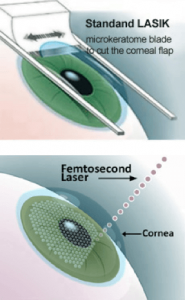Common vision or eye-related problems include farsightedness, nearsightedness, astigmatism, and presbyopia. To correct such problems, ‘refractive surgery’ is carried out. The surgical eye procedure helps reduce dependence on contact lenses or eyeglasses. Today, several types of effective surgical procedures are available, but LASIK surgery is the most popular one.

LASIK, also known as ‘laser-assisted in situ keratomileuses’, is a laser eye procedure performed to treat various vision-related problems. In LASIK surgery, the cornea is reshaped which enables the light entering into the eye to focus on the retina properly for clearer vision. In the majority of cases, LASIK surgery is completed in 15-20 minutes. It is a pain-free procedure and vision is improved without the need for eyeglasses or contact lenses.
Types of LASIK Surgery
If you are a good LASIK candidate, your eye surgeon will advise the best surgical option. Here are some common types of LASIK surgery options:
LASIK: It is the most popular form of laser eye surgery which involves creating a hinged flap in the eye cornea with the help of a sterile blade. Your surgeon then uses a laser to remove very thin layers from the cornea.
Intra-LASIK: In this procedure, your surgeon uses the laser instead of the blade to cut and reshape the cornea.
Wavefront LASIK: One of the most modern and advanced technique is Wavefront LASIK. During this procedure, a map of the cornea by a 3-dimensional scan is produced. This surgery is more accurate, and the chances of gaining 20/20 vision improve after this procedure.
LASIK Procedure
LASIK surgery is painless and hence much more comfortable than other eye surgeries. Here is the detailed LASIK procedure:
Before LASIK Surgery:
Before the surgery, your eye surgeon will carry out a thorough eye screening to ensure that you are a suitable candidate and your eyes are healthy enough for this procedure. The eye doctor will evaluate the following things:
- Size of the pupil.
- The shape of the cornea.
- The thickness of the eye cornea.
- Refractive errors such as myopia, hyperopia, astigmatism, etc.
- Moistness in the eyes.
- Condition of the posterior segment of the eye, especially the retina.
- Any other eye conditions.
Your surgeon will give guidelines which you have to follow before the surgery. You should not wear contact lenses for a certain amount of time as advised by your ophthalmologist. The surgeon will discuss important points such as what to expect during and after the procedure. The surgeon will evaluate your medical history along with the detailed eye examination. The initial tests before surgery include refraction, measuring corneal thickness, eye pressure, corneal mapping, and pupil dilation with retina evaluation.
During LASIK Procedure
To prevent any kind of discomfort, your surgeon will give local anesthesia or can give medication before the surgery. Once your eyes are numbed, your eyes will be accurately positioned under the laser, and with the help of a lid speculum instrument, the eyelids will be kept open.
Your surgeon may use an ink marker to mark the eye cornea before creating a thin flap. Then, with the help of another instrument called microkeratome, thin flap is created in the cornea. A suction ring may be used to prevent movement of the eye that could affect the quality of the flap.
Once the flap is created and painlessly peeled back, your eye surgeon will use a computer to adjust the laser as per the refractive need. You will be asked to look at the light for a small duration and the surgeon will observe the eye through a microscope when the laser sends light pulses into the cornea. Through this step, the corneal tissue is reshaped with the help of laser and the flap is put back in place. This surgery only takes 5-10 minutes for each eye.
Immediately After LASIK Surgery
As soon as your LASIK surgery is completed, your surgeon will ask you to rest for a bit. It is completely alright to feel a little blurring of vision, eye pressure or temporary burning and/or itching sensation. After some time your doctor will carry out the post-operative examination.
As your eyes will temporarily become dry and your vision may be unclear for some time, someone needs to drive you home. For dryness and to prevent inflammation or infection, the ophthalmologist will prescribe eye drops.
LASIK Surgery Outcome
Healing of the eyes after LASIK surgery occurs rapidly. Your vision may be slightly hazy or blurry for the first day. Majority of patients experience improved and clear vision within a few days of this surgery. Most people who undergo this surgery do not need glasses or contact lenses after the LASIK procedure. Generally, the outcome of LASIK surgery depends on the specific refractive error and some other factors.
Patients with a low grade of nearsightedness show the most success with this surgery, while the ones with a high degree of farsightedness or nearsightedness or with astigmatism have a less predictable outcome.
Femtosecond LASIK surgery
Nowadays, the flap making and corneal tissue reshaping can be done with the help of a femtosecond laser which is highly precise and safe. Instead of a manual blade, the laser cuts into the cornea. Patients availing this technology have reported a high level of satisfaction after surgery.

- Cornea: Overview of Corneal Diseases and Common Symptoms - April 30, 2019
- What is a Cornea Transplant? - April 29, 2019
- LASIK Surgery: Types, Procedure and Outcomes - April 26, 2019